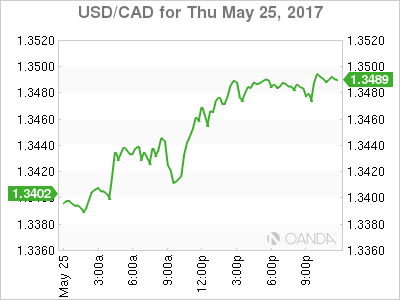The Canadian dollar depreciated on Thursday after the price of oil fell close to 5 percent after the announcement by the Organization of the Petroleum Exporting Countries (OPEC) and other major producers to extend the production cut deal by an additional 9 months. Rumours and statements ahead of at the meeting in Vienna had built up some anticipation about a longer time extension or deeper production cuts. The OPEC agreed to extend a daily 1.8 million cut to the end of the first quarter of 2018. The market had already priced in the expected extension and quickly sold crude when there was no surprise to the end of the meeting.
A Reuters poll released on Thursday showed that the Home Capital Group’s problems are not likely to affect investor confidence in the Canadian market. Three of the six major banks agreed that the situation at Home Capital is one of liquidity, not a credit issue. The ratings agency Moody’s has downgraded the banks citing a higher housing crisis exposure. Canadian banks reported earnings and boosted the TSX by easily beating estimates.
The loonie with high correlation to crude prices and a dependancy on exports to the US will be caught between the energy production fight between the US and OPEC. The renegotiation of the NAFTA is set for late August with an uncertain outcome as the US has stepped up the combative rhetoric.
The optimistic view of the Bank of Canada (BoC) towards the economy is not shared by the market as short positions on the CAD grew to a two decade high last week. Political risk in the US has not derailed its position on trade and could directly impact the Canadian economy as two thirds of exports are headed south of the border.

The USD/CAD gained 0.431 percent in the last 24 hours. The pair is trading at 1.3488 after the OPEC and other major producers announced the extension of the production cut deal for an additional 9 months. The high correlation between oil prices and the loonie dragged the currency further down as traders took profits from the crude move ahead of the OPEC meeting.
The USD came back against petrocurrencies as the price oil of fell off a cliff after the OPEC meeting. With little economic data to shore the CAD it fell ahead of the Group of seven meeting in Europe.
The USD has given back most of its post election gains. Political risk is becoming the most important driver of the currency. The turmoil surrounding the Russian links investigation is having a sizeable impact in US growth expectations as it directly impacts the timeline of the much-awaited pro-growth reforms on taxes and infrastructure spending.
The U.S. Federal Reserve is ready to hike rates in June and there is a big question mark if they will follow it with a December interest raise. Here again the central bank is awaiting for clarity in the government’s efforts to boost the economy, if the chaos results in inaction the Fed will hold putting downward pressure on the greenback.
Oil prices will continue to be caught between US rising production and the efforts of the OPEC to reduce the glut. Demand for energy continues to stagnate which makes the showdown even more intense as the US exports have begun to move into markets usually dominated by OPEC members.

The price of oil fell 5.006 percent on Thursday. The West Texas Intermediate is trading at $48.41 after the extension announcement that will take the production deal between OPEC and 11 other major producers to March of 2018. The deal managed to stabilize the price of crude following the sudden drop in the past two years. The market share grab by Saudi Arabia backfired when oil prices spiralled down. The Organization of the Petroleum Exporting Countries (OPEC) then started approaching other major producers, Russia in particular about a production freeze that evolved into the current production deal.
The newly agreed extension will keep production subdued into 2018 is an effort to keep prices stable and reduce the oil glut that currently persists in the market. On the other side of the production equation are producers that did not sign into the agreement like Brazil, Canada and the United States.
The announcement today by the Organization of the Petroleum Exporting Countries (OPEC) and other major producers will go a long way in continuing what they started this year. Their goal to stabilize crude prices has been met, but ramping production from countries not part of the agreement (Brazil, Canada and the United States) is keeping the price of oil within a certain range.
Petrocurrencies will benefit from the decision as prices will keep near current levels despite higher shale production. The Canadian dollar, Australian dollar and the Norwegian krone will appreciate as long as crude prices are stable.
The United States has gone from a net importer of crude to an exporter which could benefit the USD by boosting economic growth as the American industry appears to have withstood the headwinds from falling prices from two years ago. The Trump administration even suggested selling part of its strategic reserves which could put further pressure on oil prices and the efforts of the OPEC and other producers who have signed the extension.
Market events to watch this week:
Friday, May 26
8:30 am USD Core Durable Goods Orders m/m
8:30 am USD Prelim GDP q/q
